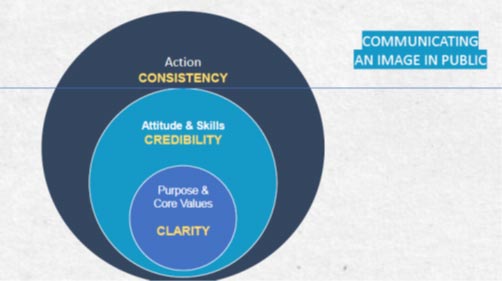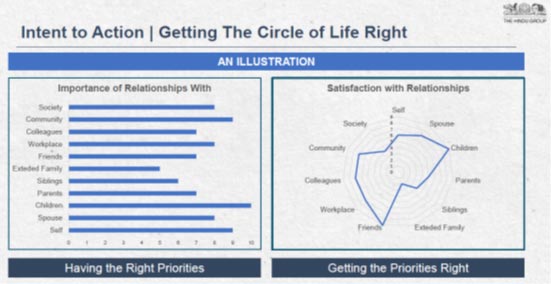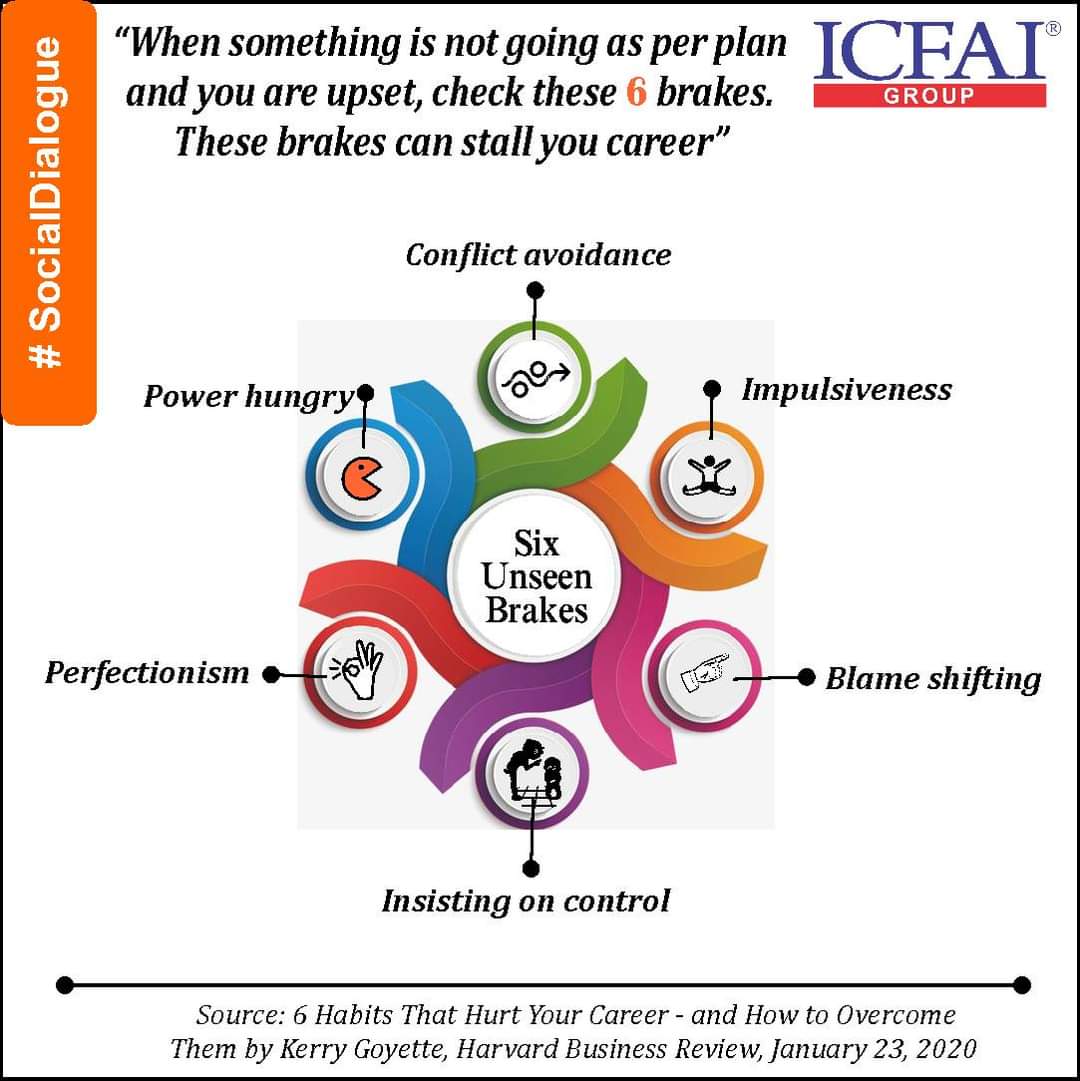
An Evening with L.V. Navaneeth: Building and Communicating a Public Image.
On July 16th, we had an insightful session by Mr. LV Navaneeth the CEO of the Hindu Group Publishing Pvt Ltd. Mr. Navaneeth is an outstanding advertising and marketing professional who was with the Hindu between 1998 and 2006 and is now back again with India’s leading newspaper. He has over twenty years of rich experience in various fields including radio broadcasting, media planning and buying, sales and marketing, distribution and content management. Above all, Mr. Navaneeth is a highly reflective, self-aware and grounded leader, who can convey his points with razor sharp clarity.
On his career
During the Q&A, Mr. Navaneeth recalled his own career. As a young boy, he had great respect for the local distributor of Hindustan Lever. He decided that he would either join the Hindu or Hindustan Lever. Looking back, Mr. Navaneeth can explain the logic behind his thinking. He was fascinated by supply and demand. He could see the trucks carrying Hindustan Lever products arriving at the distributor’s warehouse. But he also wondered what generated demand for these products. That led to his interest in marketing communication and to pursue a course at MICA.
Why does a company need a public image?
The short answer is that a good public image results in greater impact. Now impact is a combination of vision and influence. Mr Navaneeth explained this point with a striking example from the Mahabharata. During the Kurukshetra war, Sanjaya the charioteer would narrate the events on the battlefield to the blind king, Dhritarashtra. Sanjaya had infinite vision (He could see the war from a far off distance and also make out who was winning the war). But he had no influence, being from the lowest class in society. On the other hand, Dhritarashtra had no vision (both literally and as a ruler), but he had infinite influence (He could have prevented the war if he really wanted).
Mr. Navaneeth explained during the Q&A that if we do not put a high value on ourselves, we cannot expect others to raise it for us. We are no longer living in a linear world where we are in control of the narrative. So, it is important that we consciously try to cultivate our public image.
The building blocks of public image
Public image has three components: character, ability and purpose. For example, the character of ICFAI is to be an innovative institution. The ability of ICFAI is to produce skilled and ethical professionals and the purpose is nation building.
We can only communicate what we cultivate. The self-image is all about what we think we are. The public image is about how others describe us. If there is an inconsistency between the two, there will be problems. To build a strong public image, we should demonstrate consistency of character, credibility through ability and clarity in purpose.
Mr. Navaneeth reiterated during the Q&A that building a public image should not be equated with self-boasting or shouting from the rooftop. Image is not possible without substance. As a famous saying goes, good marketing can kill a bad product faster. We cannot build a public image if we do not have purpose and ability. Once we have a purpose and the ability, then we will start getting endorsements and our message will get amplified. Otherwise, our communication will only backfire.
A personal story
Mr. Navaneeth narrated a powerful personal story to explain the character, ability and purpose framework. As a school student based in Karnataka, he would visit his native place in Andhra Pradesh every summer. He deeply admired his grandfather who lived in the village and was a doctor. Despite being 80 years old (in 1985), he was not short of enthusiasm. Many people would come to him for treatment from far off places. Sometimes they would even miss their return bus and stay back at the grandfather’s home and enjoy his hospitality.
Mr. Navaneeth, inquisitive as he was, would hang around his grandfather. His grandfather would wear a long white coat with two deep pockets. He observed that after every visit, the patients would typically ask how much fees they were supposed to pay. His grandfather would tell them to pay whatever they wanted. They could drop the money into the left pocket. When some patients wanted the balance change, they could take it out from the right pocket!
Mr. Navaneeth was curious to know why his grandfather had adopted this practice. His grandfather explained that most of his patients were farmers. They were vulnerable to ups and downs based on how much crop they produced. My grandfather was particular that even if they could not pay the fees, their dignity was protected. Thus, a farmer could not afford the fees, could still put his hand inside the grandfather’s pocket and walk away without feeling any loss of dignity. This ensured that they would not hesitate to come the next time. On the other hand, if they were not able to pay the fees, they would think several times about coming back for treatment, creating potential health problems for them. Mr. Navaneeth’s grandfather felt that only if the farmers were taken care of, the nation could prosper. Thus, the character element of his grandfather was respect for others’ dignity. His grandfather’s ability was to ensure the wellbeing of farmers and his purpose was to take care of the nation.
The Comfort framework
Mr. Navaneeth explained with the help of his “Comfort” framework how we can go about building our public image.
Care: We must give time effort and money to others.
Open: We must learn by being open to feedback.
Mingle: We should interact with other people with a positive mindset.
Find: We should find new people to converse with.
Optimize: We should optimize our time and energy while pursuing our interests.
Recognise: We must identify larger issues worth solving and injustices worth correcting.
Think: We must think about and discover what we love doing.
Building credibility
Credibility consists of two components, attitude and skills.
Attitude
What are the building blocks of great attitude? It is about being
authentic, telling the truth, asking for help, admitting mistakes and
engaging others in our own self-improvement journey. Mr. Navaneeth
mentioned in this context that the topic of his presentation was new to
him. So, he decided to ask for help from various people including the
advertising guru, Ambi Parameswaran, friend Sai Krishnan, colleague,
Leo Fernandez, B Narasimhan of Sundaram Finance and another
colleague, Aparajita. He also contacted Sudhakar to get feedback on the
approach he was taking. Thanks to all these inputs, Mr Navaneeth was
able to put together his presentation.
Skills
When it comes to skills, we need both breadth and depth of knowledge.
There was a time when being a specialist was adequate. But today, we
need both specialist and broader general knowledge. Mr Navaneeth
took the example of cricket to explain this point.
In the 1970s and 1980s, it was enough for a wicket keeper to keep wickets competently. Subsequently, wicket keepers like Ian Healy emerged. They were not only great wicket keepers, but they also had a great sense of the field and could give advice to the bowlers how to set the field. Then came Adam Gilchrist who was a good wicket keeper, had a good sense of the field and was also a great batsman. If Ian Healy was a T shaped wicket keeper, Gilchrist was a pi- shaped wicketkeeper. More recently we have seen M.S. Dhoni who combines all the above attributes and also is a great captain. This is the meaning of a comb shaped professional.
Now being a specialist and generalist simultaneously does not come easily. It calls for planning and hard work. Mr. Navaneeth narrated his own experience and explained how, over the years, he has gone beyond advertising and marketing to understand other functions like H.R., administration, finance and so on.
Communicating an image in public
We should be transparent and be real. We should communicate often and consistently. To communicate an image, we can leverage our associations, the projects we work in, the people with whom we collaborate internally and so on. Then we can also leverage the owned media. For example, we could have our LinkedIn page or a Facebook page. Then we could touch the lives of others and earn endorsement from others, thereby amplifying our communication.

Mr. Navaneeth emphasised that ultimately what matters is how we like to be remembered. After we are no more, what will people say about us? What were the principles that we stood for? Who are the people we touched? How did we try to change the world in whatever small ways they might be? To leave a legacy behind, we need to have purpose, principles, touch people’s lives and show passion in what we do.
Resources for building a public image.
During the Q&A, Mr. Navaneeth explained that we can build our public image using paid, owned and earned media. The best example of paid media is advertising where we can buy space by paying money. Then we have owned media like the like the social media or our website where we can control the message the way we want it to be. Finally, we have earned media where people advocate our products or endorse our communication.
In the case of paid media, it is about investment of money. In the case of owned media, it is about investing time and energy and in the case of earned media, it is about staying true to our purpose. The benefits of paid media tend to be transient. On the other hand, the benefits of earned media are more permanent. The right intent is needed to be successful while managing the earned media.
Mr. Navaneeth added that the emergence of digital channels might have changed the tactics of building a public image, but the underlying principles have not changed.
Q&A session
The Q&A session was moderated by Prasad and Sudhakar.
On profitability and public image
Mr. Navaneeth explained that it is perfectly legitimate for a company to grow its business and profits. That is what enables a company to give back to society at scale. To that extent, purpose and profits are not inconsistent. A company must earn enough profits and then plough a part of it back for the greater good.
On maintaining consistency between our inner private image and our external public image
Mr. Navaneeth explained that we should not do anything in private that we would be uncomfortable doing in public. We should be as comfortable talking about something with our confidants as we would in a room full of people. Mr Navaneeth admitted that it is easier to achieve consistency between our inner image and our public image at an individual level. But at an organizational level, it is more difficult.
Ultimately the individual purpose must be a subset of corporate purpose. The greater the extent of alignment between the individual purpose and the corporate purpose, the happier we will be. It is the job of the leadership to find commonality between the purpose of individuals and the purpose of the company. Mr Navaneeth recalled Mr Harish Bhatt’s session last week. As he did not have to do anything questionable, Mr Bhatt had continued with the Tatas and never once thought of changing his job.
Confidence while communicating
A variety of social media have emerged, and these channels must be handled carefully. To gain confidence while communicating in public using this media, we should practice and also ask for help. We can also follow people who write with precision and purpose on the social media. If we do all this and gain experience, we will be able to build confidence next on building a public image.
On the importance of aligning individual purpose with corporate purpose
Mr. Navaneeth mentioned that we are defined by our work, but work does not define us. Work is only a means to an end. That is okay if there is no major dissonance. Perfect alignment between our purpose and what our job offers is not easy. But if we are privileged to get such a job, we should not even think of leaving the job.
Mr. Navaneeth explained that his own purpose is to address inequalities in access to education, health, infrastructure etc. He is passionate about solving problems relating to inequality at scale. That is why he feels privileged to be in an organization like the Hindu. And he always thinks about how he can enhance the stature of the Hindu.
On how the Hindu is changing its image
The Hindu is famous for its coverage of news and providing perspectives be it politics, literature, science, arts, etc. The Hindu has realised that there is no need to reinvent itself completely. The image of the Hindu is built around authenticity and credibility. The Hindu tradition is to question those in power, hold them accountable for the greater good and make people feel empowered and promote the concept of an equal and secular society.
The Hindu has a 143-year legacy, and its purpose is relevant even today. But the way to engage with the audience through the digital media has changed. Mr. Navaneeth felt that The Hindu overall has made a successful transition to the social media. It has tried to strike a balance between access and quality. The Hindu would like to provide access to as many people as possible by providing content free. At the same time, some articles must be charged to generate the resources required to produce high quality content. To sum up, the Hindu is trying to combine the best of traditional values and a modern outlook.
On the importance of image building for givers
In some professions, it is easier to give. For example, teachers and doctors have a lot of scope to give to others. Responding to a point made by Sudhakar that academics tend be reticent and do not like to come out in the public, Mr. Navaneeth mentioned that the givers can flourish only if there are seekers. so even in a profession which makes giving easier, a strong public image is required to generate more seekers. So, there is no contradiction between giving and trying to cultivate our public image. Each feeds into the other. Building a public image need not be equated with self-propagation. Rather, it enables us to make impact at scale.
On handling criticism
Prasad mentioned that in the academic world, the incentives are loaded towards doing research and knowledge generation. Most of us remember the teachers who were inspiring. But this focus on learning seems to have taken the back seat as many teachers try to conform to the norms. Mr Navaneeth responded that criticism is a part and parcel of life. As we go about doing things, we cannot make everyone happy. The people who inspired us were also criticised at some point of time. So, we must not allow criticism to bother us. Our job is not to become popular, and we should do what we feel is important. So it is perfectly legitimate to focus on high quality teaching.
Reflection exercise
Mr. Navaneeth talked about a particularly important exercise he does on his birthday every year. He makes a list of the 8 to ten relationships that really matter to him. Then he rates them on a scale how much satisfaction he is deriving from each of these relationships. Based on this, he draws a figure called the circle of life. This exercise helps Mr. Navaneeth to set his priorities and ensures that he works towards those priorities. So, setting priorities and getting the priorities right are both equally important. Over a period of 15 years, Mr. Navaneeth’s priorities have changed. For example, parents had a lower priority when he was in his mid-30s but today, they have a much higher priority. This exercise has enabled Mr. Navaneeth to be at peace with himself. Prasad added that this is indeed tapasya of a different kind; not going to the Himalayas and doing penance but instead sitting in our own environment and reflecting on what we are doing and what we think we should be doing.

On what higher education institutions can do
Mr Navaneeth feels that higher education institutions have been created to set up people for success. They do not equip students adequately to cope with failure. We should explain to students how to define success for themselves. It is important that they do not define success in terms of material rewards and success in the career. It is also important for students not to allow other people to define their success. If they can think through and define what is important for them, there will be no need to chase mirages and be disappointed in the process.
We thank Dr. Vedpuriswar for bringing out the highlights in the form of this note
